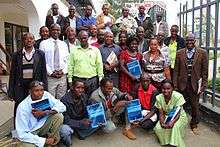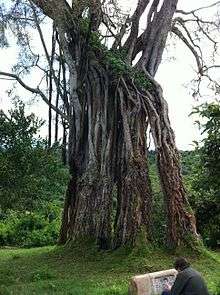Rhino Ark
Rhino Ark is a charitable trust registered as a Charity in Kenya, UK (Charity No. 1047083) and United States (with IRC 501 (c) 3 Status). Founded in 1988 the trust responded to the grave crisis facing Kenya’s Black Rhino population in the Aberdare ecosystem (see also Aberdare National Park). The Rhino were under severe threat from rampant poaching for their highly valued horn. Rhino Ark’s initial aim was to build a fence along sections of the Aberdare National Park on its Eastern Salient where rhino were being mercilessly poached. The Salient borders directly onto farming land. Wildlife was able to maraud at night into the farms bordering the park, destroying crops, creating fear and loss of both revenue and on occasions, lives. This situation fuelled an already volatile community which saw no value in protecting either the wildlife or the forest habitat. Poachers had easy access.

Rhino Ark’s formation was specifically to assist the Kenya Wildlife Service (KWS) to finance a protective fence around the Salient area which has the highest concentration of wildlife in the Aberdares. The initial project idea subsequently evolved into a much more ambitious task of encircling the entire Aberdare Conservation Area with a game proof fence. The fence, strong enough to resist elephant pressure, is powered by electricity to keep wildlife within and curb illegal log extraction, snaring, poaching of wildlife (especially rhino and the rare and elusive bongo) from without. The fence construction work started in 1989 and completed on 28 August 2009.[1] On 12 March 2010 the fence was formally commissioned by the former President of the Republic of Kenya, Hon. Mwai Kibaki.
.jpg)
Construction of the fence has brought harmony between wildlife and farmers around the Aberdare Conservation Area. The farmers now enjoy peaceful sleep at night without fear of land, crop and house destruction. Over the years, Rhino Ark’s work has evolved towards seeking sustainable, long term solutions to the conservation challenges facing mountain forest ecosystems, and other areas of important biodiversity under threat. In December 2010, Rhino Ark announced its formal commitment to supporting conservation of other mountain forest ecosystems. The initial areas of focus are Mount Kenya and Mau Mount Eburu.
In order to secure the long-term management of the fence, the Aberdare Trust was launched on 11 May 2012 by the Rt. Hon. Raila Odinga, former Prime Minister of the Republic of Kenya.[2] The Trust is a public-private partnership with strong 'Participatory Management' by communities that will manage the fence and ensure that the objectives of the fence are met, through among others, properly implemented gate management and access policy. The Trust is intended to be a role model to be replicated in the other montane forest ecosystems. Together with other Kenyan conservancies, like the Ol Pejeta Conservancy,[3] Rhino Ark shares and develops best practices for the management of electric fences.

Mission & Objectives
Rhino Ark seeks solutions in the mountain range ecosystems of Kenya and for the benefit of Eastern Africa generally to:
- Conserve such ecologically precious indigenous forests and their provision of vital environmental services;
- Create a sustainable and harmonious environment that enables people and wildlife, including all flora and fauna, to coexist;
- Create and provide sustainable programmes for forest edge communities based on payments for ecosystem services. Such programmes and projects will be tailored to create income generation for the communities that support the conservation of natural resources;
- Mobilize stakeholders nationwide and internationally for initiatives to protect and conserve the habitat and promote managed use of forest products for the benefit of present and future generations;
- Raise funds and other forms of support to develop sound management processes over entire eco-systems.
- Create frameworks where wider society and forest edge communities become involved in the management processes through public-private partnerships;
- Build mechanisms and management structures to prevent illegal exploitation of the forest habitat wherever it is threatened.
In so doing all stakeholders will benefit and the flora and fauna, particularly endangered species, will be better secured.
Rhino Ark's conservation work is anchored in three key values:
- Protecting ecosystem integrity;
- Ensuring full involvement of and participation by local communities;
- Forming effective partnerships

The overall approach is embodied in the philosophy HUMANS IN HARMONY WITH HABITAT AND WILDLIFE, and propagated though effective partnerships with stakeholders.

History of the Aberdare Fence
The Aberdares are vital to Kenya - a unique montane forest ecosystem in a country where just over two percent of land is still covered by closed canopy forest. Spanning of 160 km just north of Nairobi, the Aberdares provide invaluable services in support of the nation's economic development, human well-being and long-term environmental stability.

Impact of 20 years of conservation
In September 2011, Rhino Ark commissioned an independent study to assess the full impact of 20 years of conservation efforts in the Aberdares. The study's objectives were also to guide the future management of the Aberdare fence, as well as to provide an in-depth review of fencing as a tool to help sustainably manage a conservation area adjoining settlements, such as the Aberdare but als Mt. Kenya and other main water towers. The Environmental, Social and Economic Assessment of the Fencing of the Aberdare Conservation Area was funded by the Rhino Ark, the United Nations Environment Programme (UNEP) and the Kenya Forests Working Group and supported by the Kenya Wildlife Service, the Kenya Forest Service and the Green Belt Movement. The full report can be downloaded here: Aberdare Fence Assessment 2011
Importance of Kenya's Water Towers
Most of Kenya's forests are in mountain areas, in particular Mt. Kenya, Aberdares, Mau Complex, Cherangani Hills and Mount Elgon. These are known as the water towers of Kenya as they form the upper catchment of all but one of the main rivers in Kenya. Although these water towers cover less than 2% of the total land area in Kenya, they provide invaluable services to Kenya's inhabitants, economy and wildlife. They also support transboundary water bodies, underlining their regional and international importance.
Conserving Mount Eburu
The Eburu Forest Reserve comprises 8,715.3 hectares of prime indigenous forest area contained within the steep hills, deep valleys and rolling foothills of Mt. Eburu. In December 2010, Rhino Ark made a formal commitment to support the conservation of the Eburu ecosystem, with the construction of a comprehensive electric fence around the entire protected forest at the core of this support.

Conserving Mount Kenya
Mount Kenya, Africa's second highest mountain and Kenya's highest, sits on the equator - 180 km north of the capital Nairobi. The purpose of the Mt. Kenya Electric Fence, which will stretch 450 km in length, is to bring harmony between nature and the forest adjacent communities and to protect a natural asset of critical importance that supports economic development at national and local levels.

Public-Private Partnerships
Cooperation between the public and private sectors is playing a vital role in the success of Rhino Ark's fencing projects. Rhino Ark builds relationships with local communities, private individuals and corporations along the Government of Kenya, Kenya Wildlife Service and Kenya Forest Service that help preserve Kenya's vital ecosystems and water towers. The Government of Kenya has provided funds for both the building of the Mount Kenya and Mau Mt. Eburu fences and is supporting the maintenance of the Aberdare fence through the establishment of the Aberdare Trust. Public-Private Partnerships are also crucial in the governance, implementation and monitoring of the fencing projects.
Rhino Ark received the support of the Safaricom Foundation in 2012 when the Foundation granted the Trust KES 155 Million to assist a four-year conservation project of the Mau Eburu Forest and its wider ecosystem.[4] The Safaricom Foundation was established in August 2003 and is a registered charity funded by Safaricom Limited and the Vodafone Group Foundation. The Foundation provides a formal process for charitable contributions to communities, community groups and Non Governmental Organisations (NGOs) in Kenya who are key partners in responding to social and economic development issues in the country.
In 2013, Rhino Ark signed a partnership MoU with the World Wide Fund for Nature (WWF). The MoU provides the framework for the collaboration in the area of conservation-based community forest livelihood initiatives; access to, and sustainable management of water resources; access to sustainable energy sources; community conservation education and awareness activities.

The Fundraising Event Rhino Charge
The Rhino Charge was conceived in 1989 to raise funds for the construction of the Aberdare Electric Fence. Rhino Ark founder Ken Kuhle, Rally Enthusiast Rob Combes and Brian Haworth mooted the idea of an off-road motorsport event to support the fencing project carried out by the recently established Rhino Ark Charitable Trust. On 4 February 1989, 31 competing vehicles entered the first event which was won by Travers Allison in a Suzuki jeep. Whilst the first Rhino Charge raised only KES 250,000, this amount increased tremendously over the years to reach over KES 90 Million (over USD 1 Million) in the 2013 event.

A partner event, the UK Rhino Charge, is held every year in September in Pippingford Park, East Sussex in the United Kingdom. The event has been held every year since 1997, however it is neither as big nor as arduous as its big brother in Kenya but it does allow all types of 4x4 and entrants from enthusiastic novices to hardened experts to enjoy a very different type of day out in the country. All funds raised go towards Rhino Ark. In 2013, over £7.000 were raised.
Awards
Rhino Ark has received numerous awards by the Total S.A. Eco Challenge:
- 2006 Special Award - for the special outreach programmes for tree nurseries for fence line communities;
- 2009 Special Award - for conservation work specifically in the Aberdare ecosystem;
- 2012 Special Award - for most exceptional and sustained commitment to conservation.
- 2013 Special Award - for fundraising efforts towards the conservation of Kenya’s water towers[5]
In 2013, the Facebook page of the Fundraising Event Rhino Charge was nominated for the OLX Kenya Social Media Awards [6] in the category Best Use of Social Media - Corporate Responsibility.
Publications
Next to various research documents and maps which are available to the public (see also Rhino Ark Downloads), Rhino Ark publishes a biannual newsletter, the ARKIVE. The latest version can be downloaded here: ARKIVE Newsletter Download[7]
References
- ↑ Daily Nation, August 29, 2009: Fencing of Aberdares completed
- ↑ http://www.kws.go.ke/info/news/2012/16_aberdare_fence_2012.html
- ↑ http://www.olpejetaconservancy.org/
- ↑ http://www.safaricomfoundation.org/index.php?id=74&tx_ttnews%5Btt_news%5D=104&cHash=aa65ffd752ecb81bdeb67220bd79455a
- ↑ http://allafrica.com/stories/201307090179.html
- ↑ http://soma.or.ke/soma-2013-nominees/
- ↑ http://www.rhinoark.org/
External links
- Rhino Ark Charitable Trust
- Rhino Ark on Facebook
- Ol Pejeta Conservancy
- Rhino Ark on Twitter
- Kenya Forest Service
- Kenya Wildlife Service
- Safaricom Foundation
- Vodafone Group Foundation
- WWF
- Greenbelt Movement
- Total Eco Challenge
- Rhino Charge